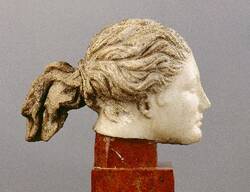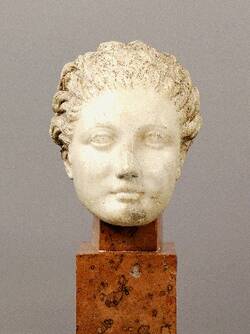The head of the Muse Polyhymnia is broken just below the chin. It belonged to a statue showing the "songful" Muse leaning on her right arm, leaning against a rocky pillar and gazing pensively into the distance. The type is known from a Hellenistic relief created and signed by the artist Archelaos from Priene. The marble relief shows the apotheosis of the poet Homer at the foot of Muses Mountain. Analogous to this representation and other statuary repetitions, the girl was depicted standing and wrapped in a cloak. The loosely gathered strands of hair are tied into a ponytail, which is freely worked and stands out from the head. Remnants of original painting have survived both in the hair and on the face. Not only has the compact mass of hair been coloured with brown paint, but fine hairs at the hairline and small curls at the temples have also been painted on. Remains of paint can also be found on the eyes, the vividness of which can still be guessed from the painting of the iris, pupils and eyebrows. An ancient coating of beeswax protected the paint from peeling off. The head is thus a telling example of the former colourfulness of ancient marble statues, of which only little remains.
Further Media



„Andra moi énnepe, Moúsa, polýtropon hós mala pólla.“
‘Sing to me of the man, Muse, the man of twists and turns...’
The opening line of Homer’s famous epic poem The Odyssey…and ever since antiquity, an appeal to the Muses for their gift of inspiration has belonged to the art of poetry. Even in the modern age, Dante and Shakespeare include such appeals in their works.
As early as the seventh century BC, the Greek poet Hesiod mentions the names of the nine Muses. They are said to be the daughters of Zeus, king of the gods, and Mnemosyne, the goddess of memory. Accompanied by Apollo on the lyre, the songs of the Muses entertained the gods on Mount Olympus. They lived on Parnassos, a mountain close to Delphi, which famously was sacred to Apollo.
The nine Muses are – in alphabetical order – Calliope, Clio, Erato, Euterpe, Melpomene, Polyhymnia, Terpsichore, Thalia, and Urania. Quite a series of names! To remember them, you would have to invent a mnemonic – a word appropriately derived from Mnemosyne, their mother.
The Muses are goddesses embodying all the liberal arts in ancient Greece. Later, particular areas of the arts were attributed to each of them with, for example, Thalia as the muse of comedy, Urania the muse of astronomy, and Terpsichore, the muse of dance. Some of their names can still be found in the cultural sector today.
As the protector goddesses of the arts, the Muses were venerated in their own shrines, known in antiquity as a Mouseion – the seat of the Muses. Appropriately, Mouseion is the origin of the modern word ‘museum’. The Muses have also given us another word as well – music.
- Location & Dating
- 2nd half of the 1st cent. CE, after an original dating to c. 160 BCE
- Material & Technique
- Marble
- Dimenions
- H: 21,0 cm, B: 18,5 cm, T: 31,5 cm
- Museum
- Skulpturensammlung
- Inventory number
- Hm 173